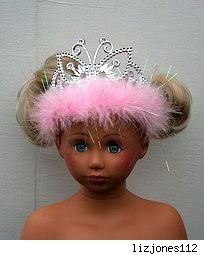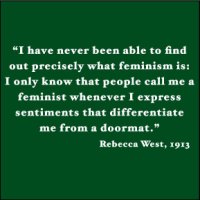It’s with some amusement I note that Melinda Tankard Reist’s Collective Shout claim they are not “slut shaming” women and girls who want, buy and wear clothes that organisation considers “sexualises” them.
They are not, they claim, targeting women and girls who wear the clothes, rather they are attacking the retailers who sell them. I suppose they are “slutty retailer shaming.”
If they attack retailers who sell the clothes of which they so strongly disapprove, they cannot help but “slut shame” the women who freely choose to buy and wear them. They are telling women and girls that the clothes “sexualise” them, that is, make them look like tramps and sluts available for male use and abuse. You can’t have these clothes, Collective Shout says, because they make you look available. If you won’t stop buying them, we’ll stop them being sold.
Their argument that they are not focussed on women but on retailers is entirely disingenuous. Of course the focus is women and girls.
Their argument fails entirely to grant women who buy these clothes agency, instead promoting the notion that certain women are incapable of choosing clothing for themselves and their daughters wisely, and are being led by the nose by retailers who should be prevented from selling these garments, thereby saving women from themselves.
Whichever way you look at it, Collective Shout is indeed “slut shaming” women and girls, as well as striving to deny them the right to choose how they will dress themselves. They are attempting to impose a dress code on women and girls, one that accords with their notions of what is and is not “sexualising.” They are attempting to gain control of the appearance of women and girls by intimidating retailers to the degree that they will only stock what Collective Shout determines to be suitable apparel.
No retailer on earth stocks products nobody wants to buy, and hopes to prosper. Clearly somebody wants the clothing Collective Shout loves to hate. Not everybody shares their aesthetic. Maybe it’s a class thing. I notice they aren’t going after David Jones and Pumpkin Patch who service the middle class and peddle a different aesthetic from Target.
What’s certain is that if someone is trying to prevent stores from stocking the clothing you want because they think it’s immoral, you are being judged and shamed for your choices by people who believe they know better than you do how you should look.
I’ve never looked at a young girl and thought, “she looks like a tramp” or more formally, “she’s been sexualised,” no matter what that girl is wearing. It’s a mystery to me why anyone would choose to first perceive a child in this way, and then speak about her in such pejorative terms.
Girls aged between seven and fourteen usually have their clothes bought for them by their mothers or primary carers. If they are allowed to shop alone, they must be given the money to do this by parents or primary caregivers and as they are living at home, presumably these adults see what the girls buy and wear. If the responsible adults don’t like what they see, I assume they can make sure they accompany the girl when next she goes clothes shopping, and exercise control over what is purchased.
I’m not sure what “trampy clothing” is or looks like. I assume it’s clothing that reveals a lot of flesh, or is cut to emphasise certain aspects of the body that are considered erogenous and therefore sexy, and therefore “trampy.” Clothing that signifies a woman who likes sex without feeling she has to get married to enjoy it, or is a sex worker.
It seems to me one can only view the body from this perspective if one first holds a moral position in which certain kinds of sex and the female body are both regarded as immoral, except under specific circumstances such as marriage or monogamous relationships.
It also seems to me that the people creating an uproar about the “sexualization” of girls have an extremely narrow understanding of what “sexy” is, and an alarming tendency to impose this limited understanding on children.
Further, they pretty much adopt the consciousness of paedophiles, of the kind that says “the girl made me do it because she was flirting and being sexy,” because what they see when they look at a girl dressed like a “sexualised” “tramp” is not a child with a child’s consciousness, but an adult looking to attract sexual encounters. A normal adult will see a child dressed up like an adult, but still a child and not converted into a sexual object by her apparel.
You can dress a child as “sexily” as you like. You can pose her as “sexily” as you like. To a normal adult human she is still a child, and not a sexual opportunity. Anyone who is imagining otherwise is potentially a paedophile. There’s no two ways about this because we are talking about interpretation, perception and desire here. These are what “sexualise” the child, not the clothing she wears.
In order for a child to be perceived as “sexy” the adult gaze must confer on her the power to arouse the desire and sexual imaginings that voluntarily occur in the adult. Otherwise she is simply a little girl in adult-like clothing that one likes, dislikes or doesn’t give a damn about.
That there are serious difficulties for girls when it comes to how they want to conduct a sexual life and how they want to present themselves to the world, is incontestable. Girls today struggle with influences and images to a degree previously unheard of, and unfortunately those influences and images portray an extremely narrow view of beauty and sexuality. We all labour under the tyranny of the majority, and the majority in large part sucks. Collective Shout will do nothing to address these problems by “slut shaming” girls and women who choose clothing that group dislikes, or by teaching girls to shame one another. They may temporarily win a minor skirmish with Target, but they will not bring about significant change in the life of girls. Shaming never achieves a thing, nor does imposing one’s own narrow perception of “appropriate” sexuality.
We live in a culture that attaches extraordinary value to appearances. Collective Shout only add to the obsession with their focus on the rightness and wrongness of what women and girls choose to wear, and the fundamentalist morality that underpins their beliefs about the female body.

































Recent Comments